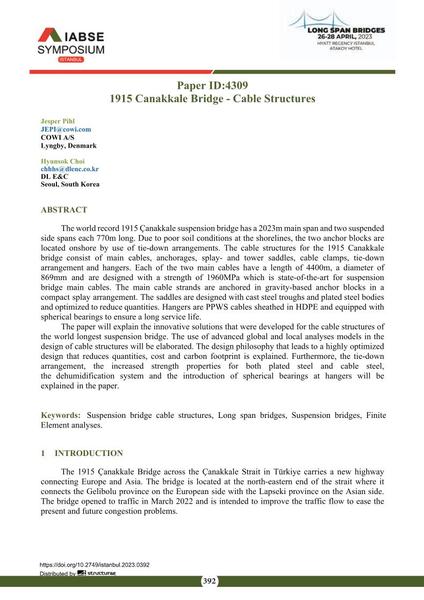1915 Canakkale Bridge - Cable Structures

|
|
|||||||||||
Bibliografische Angaben
| Autor(en): |
Jesper Pihl
(COWI A/S, Lyngby, Denmark)
Hyunsok Choi ( DL E&C, Seoul, South Korea) |
||||
|---|---|---|---|---|---|
| Medium: | Tagungsbeitrag | ||||
| Sprache(n): | Englisch | ||||
| Tagung: | IABSE Symposium: Long Span Bridges, Istanbul, Turkey, 26-28 April 2023 | ||||
| Veröffentlicht in: | IABSE Symposium Istanbul 2023 | ||||
|
|||||
| Seite(n): | 392-400 | ||||
| Anzahl der Seiten (im PDF): | 9 | ||||
| Jahr: | 2023 | ||||
| DOI: | 10.2749/istanbul.2023.0392 | ||||
| Abstrakt: |
The world record 1915 Çanakkale suspension bridge has a 2023m main span and two suspended side spans each 770m long. Due to poor soil conditions at the shorelines, the two anchor blocks are located onshore by use of tie-down arrangements. The cable structures for the 1915 Canakkale bridge consist of main cables, anchorages, splay and tower saddles, cable clamps, tie-down arrangement and hangers. Each of the two main cables have a length of 4400m, a diameter of 869mm and are designed with a strength of 1960MPa which is state-of-the-art for suspension bridge main cables. The main cable strands are anchored in gravity-based anchor blocks in a compact splay arrangement. The saddles are designed with cast steel troughs and plated steel bodies and optimized to reduce quantities. Hangers are PPWS cables sheathed in HDPE and equipped with spherical bearings to ensure a long service life. The paper will explain the innovative solutions that were developed for the cable structures of the world longest suspension bridge. The use of advanced global and local analyses models in the design of cable structures will be elaborated. The design philosophy that leads to a highly optimized design that reduces quantities, cost and carbon footprint is explained. Furthermore, the tie-down arrangement, the increased strength properties for both plated steel and cable steel, the dehumidification system and the introduction of spherical bearings at hangers will be explained in the paper. |
||||
| Stichwörter: |
Finite-Elemente-Analysen
|
||||
